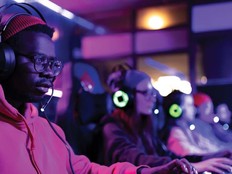Universities Invest in VR to Extend Research Potential
Augmented and virtual reality have become common tools in higher education, offering educators ways to expand the walls of their classrooms.
An EDUCAUSE report from earlier this year found that students with access to emerging technology flourish on campus, inviting administrators to invest in tools like AR and VR.
From trips to the surface of the moon to a safe environment for experimenting with dangerous chemicals, AR and VR offer a number of educational possibilities. Experts believe the true potential of these emerging technologies is just beginning to reveal itself.
Some colleges are already exploring VR’s potential, investing in new research and degree programs to delve into the virtual world and allocating resources to allow students to be innovators in the virtual space.
MORE FROM EDTECH: See how universities are exploring mixed reality to improve academic offerings.
Mixed Reality Access Opens New Doors for Research
Institutions that are bringing “mixed reality” (or XR) experiences to campus — combining AR, VR and 3D printing — are witnessing breakthroughs that translate from the virtual world to the real one.
At the University of Michigan, for example, students are using AR to design safe autonomous vehicles for future smart cities.
The test track, called MCity, uses AR tools to project traffic simulations to test the car’s interaction with other elements found on the road, such as pedestrians, stop lights or other cars.
The track was built in partnership with technology companies Verizon, LG and Intel to offer researchers and students a state-of-the-art facility.
By using AR, students and researchers can speed up the evaluation process for the driverless cars by a factor 1,000 to 100,000 — at well under the cost it would take to run live tests, according to an MCity whitepaper.
“Since virtual vehicles are used, instead of real vehicles, we can simulate risky situations without the real safety risk, we do not need to waste fuel and we can run continuously,” Huei Peng, director of MCity, told The Michigan Daily. “So it is safer, cheaper and faster compared with using real test vehicles.”
MORE FROM EDTECH: Experts weigh in on virtual reality's potential in higher education.
Students Use Virtual Reality to Improve STEM Research
In addition to creating a safer environment for experimentation, XR tools also provide students insight into dimensions that would otherwise be impossible to explore without incredibly expensive equipment and extensive training.
Steven McCloskey, a graduate of the University of California, San Diego’s first class of nanoengineers, has created an application that uses Oculus Rift headsets to view, manipulate and experiment with molecules.
The program, called Nanome, has incredible implications for both research on campus and drug development, allowing the user to experiment virtually without wasting time or resources.
“Solving protein structures is hard,” writes McCloskey. “A single misplaced residue can generate a massive misunderstanding and waste drug development efforts. A single mutation can cause diseases like sickle cell anemia.”
Meanwhile, at the University of Tampa, another student has developed a way to use VR to improve physical therapy by gamifying exercises in a virtual world. The university’s athletics department has already expressed interest in the technology, called Verapy, which combines hardware like HTC Vive or Samsung Odyssey to help student athletes get back on their feet.
“We empower patients to adhere to the therapy that their athletic trainer or their therapist has planned for them,” says Verapy’s creator, Jonathan Truong, a 2018 University of Tampa graduate. “We take mundane exercises, let’s say a flexion and extension exercise of moving the wrist up and down — instead of doing that, you can play a game while doing it.”








